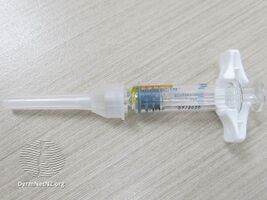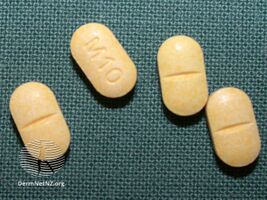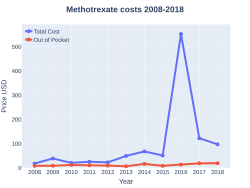Methotrexate
 | |
 | |
| Names | |
|---|---|
| Pronunciation | /ˌmɛθəˈtrɛkˌseɪt, ˌmiː-, -θoʊ-/ ( |
| Trade names | Trexall, Rheumatrex, Otrexup, others[4] |
| Other names | MTX, amethopterin |
| |
| Clinical data | |
| Main uses | Cancer, autoimmune diseases, ectopic pregnancy, medical abortions[4] |
| Side effects | Nausea, feeling tired, fever, increased risk of infection, low white blood cell counts, breakdown of the skin inside the mouth[4] |
| Pregnancy category |
|
| Routes of use | By mouth, intravenous (IV), intramuscular (IM), subcutaneous injection (SC), intrathecal |
| Defined daily dose | 2.5 mg (parenteral) 2.5 mg (by mouth)[5] |
| External links | |
| AHFS/Drugs.com | Monograph |
| MedlinePlus | a682019 |
| Legal | |
| License data |
|
| Legal status | |
| Pharmacokinetics | |
| Bioavailability | 60% at lower doses, less at higher doses.[6] |
| Protein binding | 35–50% (parent drug),[6] 91–93% (7-hydroxymethotrexate)[7] |
| Metabolism | Liver and intracellular[6] |
| Elimination half-life | 3–10 hours (lower doses), 8–15 hours (higher doses)[6] |
| Excretion | Urine (80–100%), faeces (small amounts)[6][7] |
| Chemical and physical data | |
| Formula | C20H22N8O5 |
| Molar mass | 454.447 g·mol−1 |
| 3D model (JSmol) | |
| |
| |
Methotrexate (MTX), formerly known as amethopterin, is a chemotherapy agent and immune system suppressant.[4] It is used to treat cancer, autoimmune diseases, ectopic pregnancy, and for medical abortions.[4] Types of cancers it is used for include breast cancer, leukemia, lung cancer, lymphoma, gestational trophoblastic disease, and osteosarcoma.[4] Types of autoimmune diseases it is used for include psoriasis, rheumatoid arthritis, and Crohn's disease.[4] It can be given by mouth or by injection.[4]
Common side effects include nausea, feeling tired, fever, increased risk of infection, low white blood cell counts, and breakdown of the skin inside the mouth.[4] Other side effects may include liver disease, lung disease, lymphoma, and severe skin rashes.[4] People on long-term treatment should be regularly checked for side effects.[4] It is not safe during breastfeeding.[4] In those with kidney problems, lower doses may be needed.[4] It acts by blocking the body's use of folic acid.[4]
Methotrexate was made in 1947, and initially came into medical use to treat cancer, as it was less toxic than the then-current treatments.[8] In 1956 it provided the first cures of a metastatic cancer.[9] It is on the World Health Organization's List of Essential Medicines.[10] Methotrexate is available as a generic medication.[4] It is not expensive.[11] The wholesale cost as of 2014 in the developing world is between US$0.06 and US$0.36 per day for the form taken by mouth.[12] In the United States, a typical month of treatment costs $25 to $50.[13] In 2017, it was the 117th most commonly prescribed medication in the United States, with more than six million prescriptions.[14][15]
Medical uses
Chemotherapy
Methotrexate was originally developed and continues to be used for chemotherapy, either alone or in combination with other agents. It is effective for the treatment of a number of cancers, including breast, head and neck, leukemia, lymphoma, lung, osteosarcoma, bladder, and trophoblastic neoplasms.[4]
Autoimmune disorders
It is used as a disease-modifying treatment for some autoimmune diseases, including rheumatoid arthritis, juvenile dermatomyositis, psoriasis, psoriatic arthritis, lupus, sarcoidosis, Crohn's disease,[16] eczema and many forms of vasculitis.[17][18] Although originally designed as a chemotherapy drug (using high doses), in low doses, methotrexate is a generally safe and well tolerated drug in the treatment of certain autoimmune diseases. Because of its effectiveness, low-dose methotrexate is now[when?] first-line therapy for the treatment of rheumatoid arthritis. Weekly doses are beneficial for 12 to 52 weeks duration therapy, although discontinuation rates are as high as 16% due to adverse effects.[19] Although methotrexate for autoimmune diseases is taken in lower doses than it is for cancer, side effects such as hair loss, nausea, headaches, and skin pigmentation are still common.[17][20][21] Use of low doses of methotrexate together with NSAIDS such as aspirin or analgesics such as paracetamol is relatively safe in people being treated for rheumatoid arthritis, if adequate monitoring is done.[22]
Not everyone with rheumatoid arthritis responds favorably to treatment with methotrexate, but multiple studies and reviews showed that the majority of people receiving methotrexate for up to one year had less pain, functioned better, had fewer swollen and tender joints, and had less disease activity overall as reported by themselves and their doctors. X-rays also showed that the progress of the disease slowed or stopped in many people receiving methotrexate, with the progression being completely halted in about 30% of those receiving the drug.[23] Those individuals with rheumatoid arthritis treated with methotrexate have been found to have a lower risk of cardiovascular events such as myocardial infarctions (heart attacks) and strokes.[24]
Results of a systematic review exploring the comparative effectiveness of treatments of early rheumatoid arthritis can be improved with combination therapy of tumor necrosis factor (TNF) or non-TNF biologics with methotrexate alone.[25]
Likewise, a 2016 study found the use of methotrexate, in combination with anti-TNF agents, has been shown to be effective for the treatment of ulcerative colitis.[26]
Methotrexate has also been used for multiple sclerosis[4] and is used occasionally in systemic lupus erythematosus, with tentative evidence to support such use.[27]
During pregnancy
Methotrexate is an abortifacient and is commonly used to terminate pregnancies during the early stages, generally in combination with misoprostol. It is also used to treat ectopic pregnancies, provided the fallopian tube has not ruptured.[4][28] Methotrexate with dilation and curettage is used to treat molar pregnancy.[28]
Administration
Methotrexate can be given by mouth or by injection (intramuscular, intravenous, subcutaneous, or intrathecal).[4] Doses are usually taken weekly, not daily, to limit toxicity.[4] Routine monitoring of the complete blood count, liver function tests, and creatinine are recommended.[4] Measurements of creatinine are recommended at least every two months.[4]
-
Methotrexate injection
-
Methotrexate tablets
Dosage
The defined daily dose is 2.5 mg (by injection or by mouth).[5]
Side effects
The most common adverse effects include: hepatotoxicity (liver damage), ulcerative stomatitis, leukopenia and thus predisposition to infection, nausea, abdominal pain, fatigue, fever, dizziness, acute pneumonitis, rarely pulmonary fibrosis, and kidney failure.[4][17] Methotrexate is teratogenic and hence is not advised for either the prospective father to take it before or for the mother to take it before or during pregnancy (pregnancy category X) and for a period after birth.[29]
Central nervous system reactions to methotrexate have been reported, especially when given via the intrathecal route (directly into the cerebrospinal fluid), which include myelopathies and leucoencephalopathies. It has a variety of cutaneous side effects, particularly when administered in high doses.[30]
Another little understood but serious possible adverse effect of methotrexate is neurological damage and memory loss.[31] Neurotoxicity may result from the drug crossing the blood–brain barrier and damaging neurons in the cerebral cortex. People with cancer who receive the medication often nickname these effects "chemo brain" or "chemo fog".[31]
Drug interactions
Penicillins may decrease the elimination of methotrexate, so increase the risk of toxicity.[4] While they may be used together, increased monitoring is recommended.[4] The aminoglycosides, neomycin and paromomycin, have been found to reduce gastrointestinal (GI) absorption of methotrexate.[32] Probenecid inhibits methotrexate excretion, which increases the risk of methotrexate toxicity.[32] Likewise, retinoids and trimethoprim have been known to interact with methotrexate to produce additive hepatotoxicity and haematotoxicity, respectively.[32] Other immunosuppressants like cyclosporins may potentiate methotrexate's haematologic effects, hence potentially leading to toxicity.[32] NSAIDs have also been found to fatally interact with methotrexate in numerous case reports.[32] Nitrous oxide potentiating the haematological toxicity of methotrexate has also been documented.[32] Proton-pump inhibitors such as omeprazole and the anticonvulsant valproate have been found to increase the plasma concentrations of methotrexate, as have nephrotoxic agents such as cisplatin, the GI drug colestyramine, and dantrolene.[32]
Mechanism of action

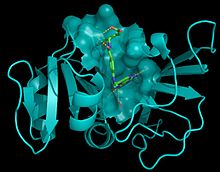
Methotrexate is an antimetabolite of the antifolate type. It is thought to affect cancer and rheumatoid arthritis by two different pathways. For cancer, methotrexate competitively inhibits dihydrofolate reductase (DHFR), an enzyme that participates in the tetrahydrofolate synthesis.[33][34] The affinity of methotrexate for DHFR is about 1000-fold that of folate. DHFR catalyses the conversion of dihydrofolate to the active tetrahydrofolate.[33] Folic acid is needed for the de novo synthesis of the nucleoside thymidine, required for DNA synthesis.[33] Also, folate is essential for purine and pyrimidine base biosynthesis, so synthesis will be inhibited. Methotrexate, therefore, inhibits the synthesis of DNA, RNA, thymidylates, and proteins.[33]
For the treatment of rheumatoid arthritis, inhibition of DHFR is not thought to be the main mechanism, but rather multiple mechanisms appear to be involved, including the inhibition of enzymes involved in purine metabolism, leading to accumulation of adenosine; inhibition of T cell activation and suppression of intercellular adhesion molecule expression by T cells; selective down-regulation of B cells; increasing CD95 sensitivity of activated T cells; and inhibition of methyltransferase activity, leading to deactivation of enzyme activity relevant to immune system function.[35][36] Another mechanism of MTX is the inhibition of the binding of interleukin 1-beta to its cell surface receptor.[37]
History
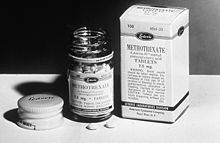
In 1947, a team of researchers led by Sidney Farber showed aminopterin, a chemical analogue of folic acid developed by Yellapragada Subbarao of Lederle, could induce remission in children with acute lymphoblastic leukemia. The development of folic acid analogues had been prompted by the discovery that the administration of folic acid worsened leukemia, and that a diet deficient in folic acid could, conversely, produce improvement; the mechanism of action behind these effects was still unknown at the time.[38] Other analogues of folic acid were in development, and by 1950, methotrexate (then known as amethopterin) was being proposed as a treatment for leukemia.[39] Animal studies published in 1956 showed the therapeutic index of methotrexate was better than that of aminopterin, and clinical use of aminopterin was thus abandoned in favor of methotrexate.
In 1951, Jane C. Wright demonstrated the use of methotrexate in solid tumors, showing remission in breast cancer.[40] Wright's group was the first to demonstrate use of the drug in solid tumors, as opposed to leukemias, which are a cancer of the marrow. Min Chiu Li and his collaborators then demonstrated complete remission in women with choriocarcinoma and chorioadenoma in 1956,[41] and in 1960 Wright et al. produced remissions in mycosis fungoides.[42][43]
Research
In 2018, a photoactivated version of methotrexate (phototrexate) has been developed and proposed to be useful in localized, target-specific chemotherapy of psoriasis and cancer.[44]
Society and culture
Cost
The wholesale cost as of 2014 in the developing world is between US$0.06 and US$0.36 per day for the form taken by mouth.[12] In the United States, a typical month of treatment costs $25 to $50.[45]5 In 2017, it was the 117th most commonly prescribed medication in the United States, with more than six million prescriptions.[14][15]
-
Methotrexate costs (US)
-
Methotrexate prescriptions (US)
References
- ↑ "methotrexate – definition of methotrexate in English from the Oxford dictionary". OxfordDictionaries.com. Archived from the original on 2015-12-04. Retrieved 2016-01-20.
- ↑ "methotrexate". Merriam-Webster Dictionary.
- ↑ "methotrexate". Dictionary.com Unabridged. Random House.
- ↑ 4.00 4.01 4.02 4.03 4.04 4.05 4.06 4.07 4.08 4.09 4.10 4.11 4.12 4.13 4.14 4.15 4.16 4.17 4.18 4.19 4.20 4.21 4.22 4.23 4.24 "Methotrexate". The American Society of Health-System Pharmacists. Archived from the original on 2016-10-08. Retrieved 22 Aug 2016.
- ↑ 5.0 5.1 "WHOCC - ATC/DDD Index". www.whocc.no. Archived from the original on 6 November 2020. Retrieved 21 September 2020.
- ↑ 6.0 6.1 6.2 6.3 6.4 "Trexall, Rheumatrex (methotrexate) dosing, indications, interactions, adverse effects, and more". Medscape Reference. WebMD. Archived from the original on 8 February 2014. Retrieved 12 April 2014.
- ↑ 7.0 7.1 Bannwarth B, Labat L, Moride Y, Schaeverbeke T (January 1994). "Methotrexate in rheumatoid arthritis. An update". Drugs. 47 (1): 25–50. doi:10.2165/00003495-199447010-00003. PMID 7510620.
- ↑ Sneader, Walter (2005). Drug Discovery: A History. John Wiley & Sons. p. 251. ISBN 9780470015520. Archived from the original on 2017-02-16.
- ↑ "Today's anti-cancer tools are ever better wielded". The Economist. 14 September 2017. Archived from the original on 15 May 2018. Retrieved 16 September 2017.
- ↑ World Health Organization (2019). World Health Organization model list of essential medicines: 21st list 2019. Geneva. hdl:10665/325771. WHO/MVP/EMP/IAU/2019.06. License: CC BY-NC-SA 3.0 IGO.
- ↑ Hitchings, Andrew; Lonsdale, Dagan; Burrage, Daniel; Baker, Emma (2019). The Top 100 Drugs: Clinical Pharmacology and Practical Prescribing (2nd ed.). Elsevier. pp. 156–157. ISBN 978-0-7020-7442-4. Archived from the original on 2021-05-22. Retrieved 2021-11-09.
- ↑ 12.0 12.1 "Methotrexate Sodium". International Drug Price Indicator Guide. Archived from the original on 11 June 2019. Retrieved 23 August 2016.
- ↑ Hamilton, Richart (2015). Tarascon Pocket Pharmacopoeia 2015 Deluxe Lab-Coat Edition. Jones & Bartlett Learning. p. 464. ISBN 9781284057560.
- ↑ 14.0 14.1 "The Top 300 of 2020". ClinCalc. Archived from the original on 12 February 2021. Retrieved 11 April 2020.
- ↑ 15.0 15.1 "Methotrexate - Drug Usage Statistics". ClinCalc. Archived from the original on 8 July 2020. Retrieved 11 April 2020.
- ↑ Herfarth HH, Long MD, Isaacs KL (2012). "Methotrexate: underused and ignored?". Digestive Diseases. 30 Suppl 3: 112–8. doi:10.1159/000342735. PMC 4629813. PMID 23295701.
- ↑ 17.0 17.1 17.2 Rossi S, ed. (2013). Australian Medicines Handbook (2013 ed.). Adelaide: The Australian Medicines Handbook Unit Trust. ISBN 978-0-9805790-9-3.
- ↑ Joint Formulary Committee (2013). British National Formulary (BNF) (65 ed.). London, UK: Pharmaceutical Press. ISBN 978-0-85711-084-8.
- ↑ Lopez-Olivo MA, Siddhanamatha HR, Shea B, Tugwell P, Wells GA, Suarez-Almazor ME (June 2014). "Methotrexate for treating rheumatoid arthritis". The Cochrane Database of Systematic Reviews (6): CD000957. doi:10.1002/14651858.CD000957.pub2. PMC 7047041. PMID 24916606.
- ↑ Cronstein BN (June 2005). "Low-dose methotrexate: a mainstay in the treatment of rheumatoid arthritis". Pharmacological Reviews. 57 (2): 163–72. doi:10.1124/pr.57.2.3. PMID 15914465. Archived from the original on 2021-08-28. Retrieved 2019-12-17.
- ↑ American Rheumatoid Arthritis Guidelines (February 2002). "Guidelines for the management of rheumatoid arthritis: 2002 Update". Arthritis and Rheumatism. 46 (2): 328–46. doi:10.1002/art.10148. PMID 11840435.
- ↑ Colebatch AN, Marks JL, Edwards CJ (November 2011). "Safety of non-steroidal anti-inflammatory drugs, including aspirin and paracetamol (acetaminophen) in people receiving methotrexate for inflammatory arthritis (rheumatoid arthritis, ankylosing spondylitis, psoriatic arthritis, other spondyloarthritis)". The Cochrane Database of Systematic Reviews (11): CD008872. doi:10.1002/14651858.CD008872.pub2. PMID 22071858.
- ↑ Weinblatt ME (2013). "Methotrexate in rheumatoid arthritis: a quarter century of development". Transactions of the American Clinical and Climatological Association. 124: 16–25. PMC 3715949. PMID 23874006.
- ↑ Marks JL, Edwards CJ (June 2012). "Protective effect of methotrexate in patients with rheumatoid arthritis and cardiovascular comorbidity". Therapeutic Advances in Musculoskeletal Disease. 4 (3): 149–57. doi:10.1177/1759720X11436239. PMC 3400102. PMID 22850632.
- ↑ Donahue KE, Schulman ER, Gartlehner G, Jonas BL, Coker-Schwimmer E, Patel SV, et al. (October 2019). "Comparative Effectiveness of Combining MTX with Biologic Drug Therapy Versus Either MTX or Biologics Alone for Early Rheumatoid Arthritis in Adults: a Systematic Review and Network Meta-analysis". Journal of General Internal Medicine. 34 (10): 2232–2245. doi:10.1007/s11606-019-05230-0. PMC 6816735. PMID 31388915. Archived from the original on 2021-08-28. Retrieved 2021-02-18.
- ↑ Herfarth HH (2016-01-01). "Methotrexate for Inflammatory Bowel Diseases - New Developments". Digestive Diseases. 34 (1–2): 140–6. doi:10.1159/000443129. PMC 4820247. PMID 26981630.
- ↑ Tsang-A-Sjoe MW, Bultink IE (2015). "Systemic lupus erythematosus: review of synthetic drugs". Expert Opinion on Pharmacotherapy. 16 (18): 2793–806. doi:10.1517/14656566.2015.1101448. PMID 26479437.
] To date, three small [86–88] RCTs in SLE patients have been published, including in total 76 patients in the active arm
- ↑ 28.0 28.1 Mol F, Mol BW, Ankum WM, van der Veen F, Hajenius PJ (2008). "Current evidence on surgery, systemic methotrexate and expectant management in the treatment of tubal ectopic pregnancy: a systematic review and meta-analysis". Human Reproduction Update. 14 (4): 309–19. doi:10.1093/humupd/dmn012. PMID 18522946.
- ↑ Gromnica-Ihle E, Krüger K (2010-09-01). "Use of methotrexate in young patients with respect to the reproductive system". Clinical and Experimental Rheumatology. 28 (5 Suppl 61): S80-4. PMID 21044438.
- ↑ Scheinfeld N (December 2006). "Three cases of toxic skin eruptions associated with methotrexate and a compilation of methotrexate-induced skin eruptions". Dermatology Online Journal. 12 (7): 15. PMID 17459301.
- ↑ 31.0 31.1 Hafner DL (August 2009). "Lost in the fog: understanding "chemo brain"". Nursing. 39 (8): 42–5. doi:10.1097/01.nurse.0000358574.56241.2f. PMID 19633502.
- ↑ 32.0 32.1 32.2 32.3 32.4 32.5 32.6 Brayfield A, ed. (6 January 2014). "Methotrexate". Martindale: The Complete Drug Reference. Pharmaceutical Press. Archived from the original on 28 August 2021. Retrieved 12 April 2014.
- ↑ 33.0 33.1 33.2 33.3 Rajagopalan PT, Zhang Z, McCourt L, Dwyer M, Benkovic SJ, Hammes GG (October 2002). "Interaction of dihydrofolate reductase with methotrexate: ensemble and single-molecule kinetics". Proceedings of the National Academy of Sciences of the United States of America. 99 (21): 13481–6. Bibcode:2002PNAS...9913481R. doi:10.1073/pnas.172501499. PMC 129699. PMID 12359872.
- ↑ Goodsell DS (August 1999). "The molecular perspective: methotrexate". The Oncologist. 4 (4): 340–1. doi:10.1634/theoncologist.4-4-340. PMID 10476546. Archived from the original on 2012-05-24. Retrieved 2013-06-17.
- ↑ Wessels JA, Huizinga TW, Guchelaar HJ (March 2008). "Recent insights in the pharmacological actions of methotrexate in the treatment of rheumatoid arthritis" (PDF). Rheumatology. 47 (3): 249–55. doi:10.1093/rheumatology/kem279. PMID 18045808. Archived (PDF) from the original on 2015-10-10. Retrieved 2014-04-13.
- ↑ Böhm I (June 2004). "Increased peripheral blood B-cells expressing the CD5 molecules in association to autoantibodies in patients with lupus erythematosus and evidence to selectively down-modulate them". Biomedicine & Pharmacotherapy = Biomedecine & Pharmacotherapie. 58 (5): 338–43. doi:10.1016/j.biopha.2004.04.010. PMID 15194170.
- ↑ Brody M, Böhm I, Bauer R (October 1993). "Mechanism of action of methotrexate: experimental evidence that methotrexate blocks the binding of interleukin 1 beta to the interleukin 1 receptor on target cells". European Journal of Clinical Chemistry and Clinical Biochemistry. 31 (10): 667–74. CiteSeerX 10.1.1.633.8921. doi:10.1515/cclm.1993.31.10.667. PMID 8292668.
- ↑ Bertino JR (2000). "Methotrexate: historical aspects". In Cronstein BN, Bertino JR (eds.). Methotrexate. Basel: Birkhäuser. ISBN 978-3-7643-5959-1. Archived from the original on 2017-02-15. Retrieved 2016-09-24.[page needed]
- ↑ Meyer LM, Miller FR, Rowen MJ, Bock G, Rutzky J (September 1950). "Treatment of acute leukemia with amethopterin (4-amino, 10-methyl pteroyl glutamic acid)". Acta Haematologica. 4 (3): 157–67. doi:10.1159/000203749. PMID 14777272.
- ↑ Wright JC, Prigot A, Wright B, Weintraub S, Wright LT (July 1951). "An evaluation of folic acid antagonists in adults with neoplastic diseases: a study of 93 patients with incurable neoplasms". Journal of the National Medical Association. 43 (4): 211–40. PMC 2616951. PMID 14850976.
- ↑ Hertz R, Li MC, Spencer DB (November 1956). "Effect of methotrexate therapy upon choriocarcinoma and chorioadenoma". Proceedings of the Society for Experimental Biology and Medicine. 93 (2): 361–6. doi:10.3181/00379727-93-22757. PMID 13379512.
- ↑ Wright JC, Gumport SL, Golomb FM (November 1960). "Remissions produced with the use of Methotrexate in patients with mycosis fungoides". Cancer Chemotherapy Reports. 9: 11–20. PMID 13786791.
- ↑ Wright JC, Lyons MM, Walker DG, Golomb FM, Gumport SL, Medrek TJ (August 1964). "Observations on the Use of Cancer Chemotherapeutic Agents in Patients With Mycosis Fungoides". Cancer. 17 (8): 1045–62. doi:10.1002/1097-0142(196408)17:8<1045::AID-CNCR2820170811>3.0.CO;2-S. PMID 14202592.
- ↑ Matera C, Gomila AM, Camarero N, Libergoli M, Soler C, Gorostiza P (November 2018). "Photoswitchable Antimetabolite for Targeted Photoactivated Chemotherapy". Journal of the American Chemical Society. 140 (46): 15764–15773. doi:10.1021/jacs.8b08249. hdl:2445/126377. PMID 30346152.
- ↑ Cite error: Invalid
<ref>tag; no text was provided for refs namedRic20
External links
| External sites: | |
|---|---|
| Identifiers: |
|
- National Rheumatoid Arthritis Society (NRAS) Archived 2019-12-30 at the Wayback Machine article on Methotrexate
- Methotrexate Injection Archived 2016-07-05 at the Wayback Machine MedlinePlus article from NIH
- Patient Education – Methotrexate Archived 2020-05-02 at the Wayback Machine from American College of Rheumatology
- Pages using duplicate arguments in template calls
- Pages with reference errors
- CS1: long volume value
- Wikipedia articles needing page number citations from December 2010
- Articles with invalid date parameter in template
- Articles with hatnote templates targeting a nonexistent page
- Articles with hAudio microformats
- Pages including recorded pronunciations
- Drugs with non-standard legal status
- Chemical articles with unknown parameter in Infobox drug
- Chemical articles without CAS registry number
- Articles without EBI source
- Chemical pages without ChemSpiderID
- Chemical pages without DrugBank identifier
- Articles without KEGG source
- Articles without UNII source
- Drugs missing an ATC code
- Drug has EMA link
- Drugboxes which contain changes to watched fields
- All articles with vague or ambiguous time
- Vague or ambiguous time from December 2019
- Webarchive template wayback links
- Antifolates
- Antirheumatic products
- Benzamides
- Chemotherapy
- Hepatotoxins
- IARC Group 3 carcinogens
- Immunosuppressants
- Mammalian dihydrofolate reductase inhibitors
- Nephrotoxins
- World Health Organization essential medicines
- RTT
